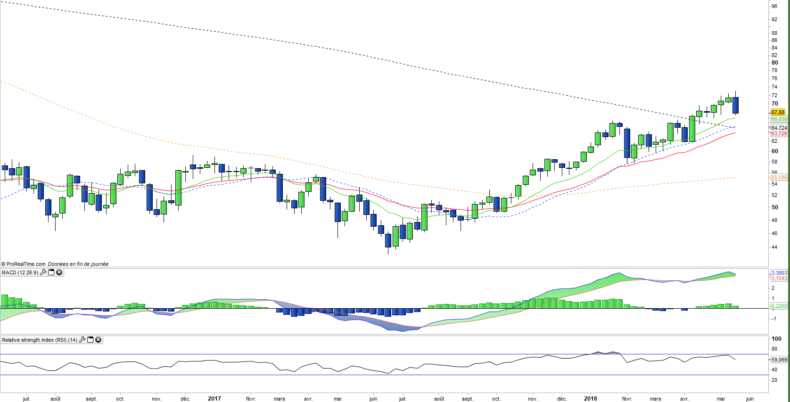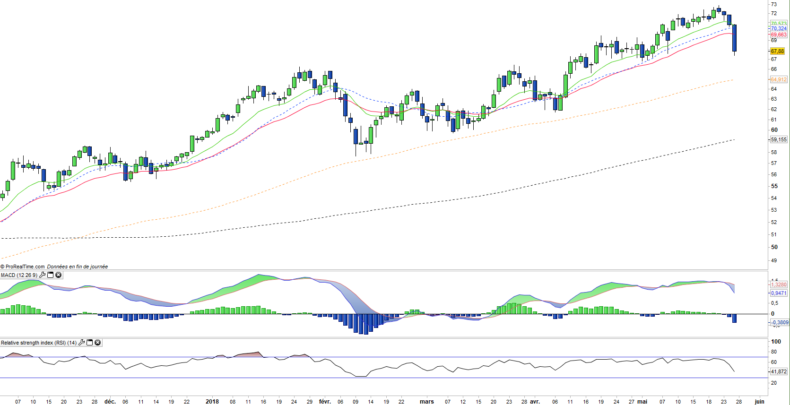PowerShares Oil WTI - DBO - 28/05/2018
Short Term strategy: Positive (80%) / Trend -
Long Term strategy: Positive (70%) / Trend +
Characteristics of the ETF
The DBO ETF (Invesco-Powershares) created in 05/2007 replicates the crude oil prices through future contracts on light sweet crude oil (WTI).
The costs of the DBO ETF are 0.75% and AUM amount to approximately $380M. Oil is a very volatile asset, and as any commodity does not give rise to a dividend and is a risky asset.
Alternative ETFs: OLO (Deutsche Bank USD), BNO (US Commodity Fund USD).
Latest developments
WTI oil rose for the second consecutive year in 2017 (+ 4.9%) after a rebound of 9.2% in 2016 and is now up 13.3% in 2018.
The rise in oil in recent months has been linked to the reconstitution of the geopolitical premium with the tensions in the Middle East that led to the return of sanctions on Iran by the USA.
In addition, OPEC's production cuts have largely continued to stabilize the market, which is still heavily impacted by the American shale oil oversupply.
But WTI prices were impacted last week by speculation about an increase in production by OPEC and its allies in response to US sanctions against Iran and Venezuela, during a Meeting in St. Petersburg, the Saudi and Russian Energy Ministers, accompanied by their counterpart from the United Arab Emirates, who holds the presidency of OPEC this year, reportedly discussed an increase in the production of the cartel and its partners of about one million barrels a day.
Index & components
Oil is a raw material that is a fossil fuel produced by a few countries like Saudi Arabia, the US, Russia, Iran, Iraq, Algeria or Nigeria.
It is extracted by drilling or hydraulic fracturing and is then delivered - processed / refined or not, in consumer countries, mainly European and Asian and can produce fuels such as gasoline, gas oil or kerosene once refined and processed chemically. Depending on its origin and final destination, oil has different names and its price may also vary.
These differences in the price of oil depend on its quality. We differentiate the Arabian Light, which comes from the Middle East, the Brent oil that is produced in the North Sea, and finally the WTI or "West Texas Intermediate" which is produced in the United States and is the benchmark of the oil market. The reference unit for oil is the barrel, which is actually about 159 liters. The price of a barrel of oil is quoted on the international market continuously, while two financial centers share its rating, namely New York for WTI and London for Brent. Supply, therefore production and its stability are of course key determinants of the price of a barrel.
It is OPEC, made up of several major world producing countries, which is in charge of determining - by consensus - how many barrels a day will be produced and its publications are therefore followed with attention by traders, as was the case recently. Demand factors are also critical. Thus, an increase in the energy needs of a major consumer country may have a greater or lesser influence on the price of the barrel. Globally, global growth is a very important factor for demand, while oil needs tend to shrink at equal demand, as new technologies tend to reduce consumption.
In the long term, the electric car could cause a negative shock on global demand for crude oil, as China is investing heavily in renewable energy. Since 2014, oil prices have divided by 3 due to a supply shock caused by the arrival on the market of American shale oil which has put very strong pressure on the oil-producing and oil companies that have significantly reduced their investments.
This stoppage of industrial investment, in addition to OPEC's production cuts, has for the moment had a moderate bullish impact on crude prices. This is due to the plethoric production of unconventional oil (shale) that floods the market and counterbalances OPEC's reduction efforts.
Weekly data
On the weekly chart, we can see a bearish engulfing that involves a correction of the last months upward movement. For some time the corrections are quite short in duration and amplitudes and usually retest the EMA20 currently located at $65. This level is therefore the natural target of the correction. Oscillators remain bullish and this correction should not threaten the long-term uptrend.
Daily data
The daily chart shows a rather abrupt corrective start, whose main objective is the EMA100 around $ 65. The second rampart is materialized by the EMA200 located at $ 61, which also corresponds to the current upward crossing of the monthly EMA13 and 26. This bearish start has resulted in the reversal of technical oscillators, and the large black candlestick formed on Friday implies a likely short term continuation of the decline towards the objective.
ETF Objective
DBO is an ETF listed in $, which seeks to replicate the DBIQ Optimum Yield Crude Oil Index Excess Return
Characteristics
| Inception date | 01/05/2007 |
| Expense ratio | 0,78% |
| Issuer | Powershares (Invesco) |
| Benchmark | DBIQ Optimum Yield Crude Oil Index Excess Return |
| code/ticker | DBO |
| ISIN | US73936B5075 |
| Currency | $ |
| Exchange | NYSE |
| Assets Under Management | 380 M$ |
| Dividend | No |
| Currency Risk | No |
| Number of Holdings | NS |
| Risk | 4/5 |
Country Breakdown
| USA | 100% |
Sector Breakdown
| Oil WTI | 100% |
Top Ten Holdings
| Oil WTI | 100% |


